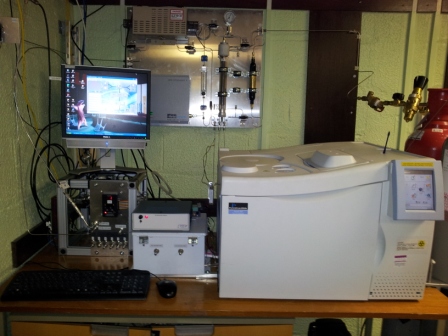Instrument Support Level 3
Perkin Elmer, Clarus 500 Gas Chromatograph
Not Applicable
Calendar

ECD on Clarus 500 Greenhouse Gas Chromatograph - SF6 Monitor
The Electron Capture Detector (ECD) on the Clarus 500 Greenhouse Gas Chromatograph (GC) at Weybourne Atmospheric Observatory is used to make quasi-continuous measurements of sulphur hexafluoride (SF6) in atmospheric air. Samples are analysed every ten minutes and with reference to the NOAA2006 scale for SF6. In addition the instrument can determine the SF6 concentrations in discrete samples (i.e. whole air samples, SilcoCans).
Routine analysis of atmospheric sulfurhexafluoride (SF6) is achieved using a modified commercial Gas Chromatograph (Clarus 500, Perkin Elmer), which includes gas chromatography followed by detection of SF6 using an Electron Capture Detector (ECD).
Air is drawn from the top of the sampling tower (25 masl) through ¼” tubing (Synflex 1300) at a flow rate of 200 cm3 min–1 using a diaphragm pump (N86-ATE, KNF) upstream of the sample loop. To prevent particulate matter from entering the analytical instrumentation the sample line is fitted with a 40 micron filter at the top of the tower and a 2 micron filter at the base of the tower (TF-series, Swagelok). The air is then passed through a counter-flow Nafion drier (MD-series, Perma Pure) to remove the bulk of the moisture. Following this the air is passed through an ethanol chiller trap (-90°C) before flushing a 10 cm3 sample loop held at a constant temperature of 80° C inside a controlled zone. The return ‘dry’ airflow from the sample loop is used as the counter flow gas for the Nafion drier. Prior to the sample loop injection, the sample pressure is allowed to equilibrate for 0.5 mins.
The air in the sample loop is injected at 0.5 mins and immediately enters the pre-column containing Hayesep Q (80/100 mesh, stainless steel, 3/16” OD x 200 cm length) which is operated at a constant temperature of 65° C. This stage allows any contaminants to vent (e.g. air, oxygen). After 5.5 mins the sample is transferred to a second Hayesep Q column identical to the pre-column and the pre-column is back-flushed. Following further separation of SF6 it elutes at 8.1 mins and enters the ECD.
The carrier gas used in this system is nitrogen N4.8 grade (99.998 % purity, BOC) at a flow rate of 60 ml min-1 during chromatographic separation and 100 ml min-1 during the back-flushing of the pre-column. This is further purified using a heated getter (Supelco, model no. 29546-U) and OMI purifier tube (Supelco, model no. 23909) to reduce impurities below 10 ppb. The ECD is operated at 370°C with 5 % CH4/Argon as make-up gas at a flow rate of 1 ml min-1.
A run time of 10 min allows five air samples to be analysed every hour with a working standard analysed after every sixth run. The detector response is recorded and analysed using Perkin Elmer GC control software (TCNav 6.3.2). Normalised peak heights (peak height/average of bracketing working standards) measured from samples are referenced to the instrument’s non-linear response function of the Electron Capture Detector (ECD) to SF6. This is determined on a weekly basis using calibrated primary reference gases on the NOAA2006 scale for SF6 which are produced and calibrated at MPI-Jena. The range of concentrations in the primary reference gases is 7.5 ppt to 15.9 ppt (5 cylinders) for SF6. Instrument repeatability will be assessed by calculating the deviation in the concentration of the working standard from the bracketing two working standards as the concentration of this is known and will be determined at the same time as the non-linear response function. The accuracy of the system will be assessed through the analysis of a target gas every 6 hours. The target gas is a cylinder of gas with accurately assigned concentrations of the target species determined at a central calibration laboratory (in this instance MPI-Jena). This target gas will be introduced to the system as a sample and following analysis the deviation of SF6 concentrations from the assigned concentrations will be calculated. We also take part in International inter-comparison programs (i.e. WMO round-robins, Cucumbers), see useful links.
Routine data work-up occurs on a monthly basis using bespoke procedures written for Igor Pro.
The non-linear response function of the Electron Capture Detector (ECD) to SF6 will be determined on a weekly basis using calibrated primary reference gases on the NOAA2006 scale for SF6 which are produced and calibrated at MPI-Jena. The range of concentrations in the primary reference gases is 7.5 ppt to 15.9 ppt (5 cylinders) for SF6. Instrument repeatability will be assessed by calculating the deviation in the concentration of the working standard from the bracketing two working standards as the concentration of this is known and will be determined at the same time as the non-linear response function. The accuracy of the system will be assessed through the analysis of a target gas every 6 hours. The target gas is a cylinder of gas with accurately assigned concentrations of the target species determined at a central calibration laboratory (in this instance MPI-Jena). This target gas will be introduced to the system as a sample and the following analysis the deviation of SF6 concentrations from the assigned concentrations will be calculated. We also take part in International inter-comparison programs (i.e. WMO round-robins, Cucumbers), see links.
Archive data
- Data is provided in NetCDF files following the AMOF data standard
- Files contain no more than 24hr of data.
- Instrument name is
- ncas-ghg-gc-ecd-1
- The data product(s) associated with this instrument:
- Example data file
